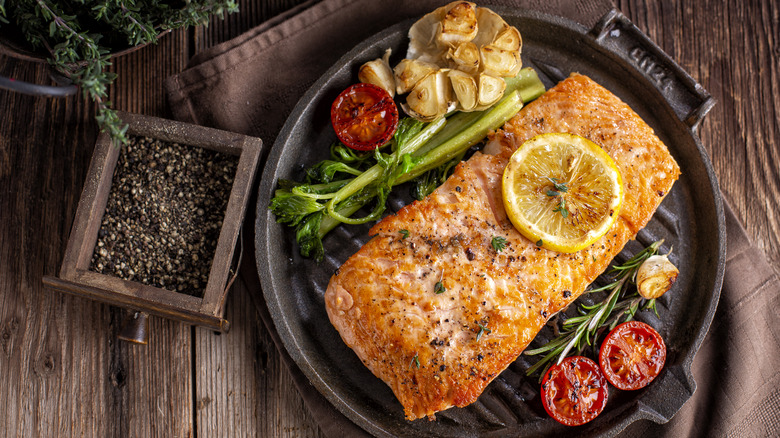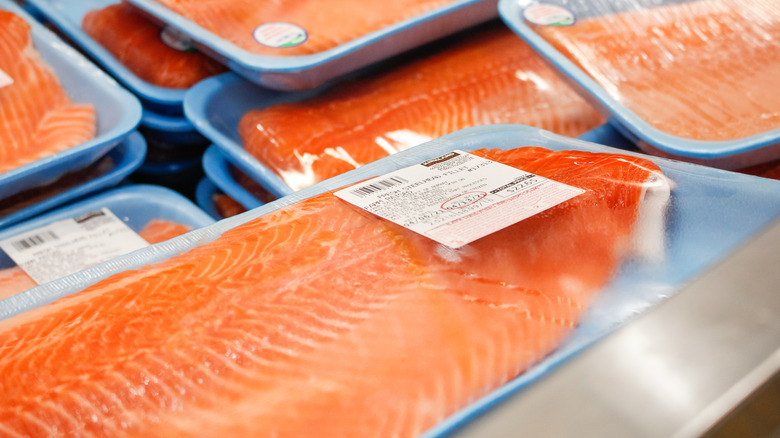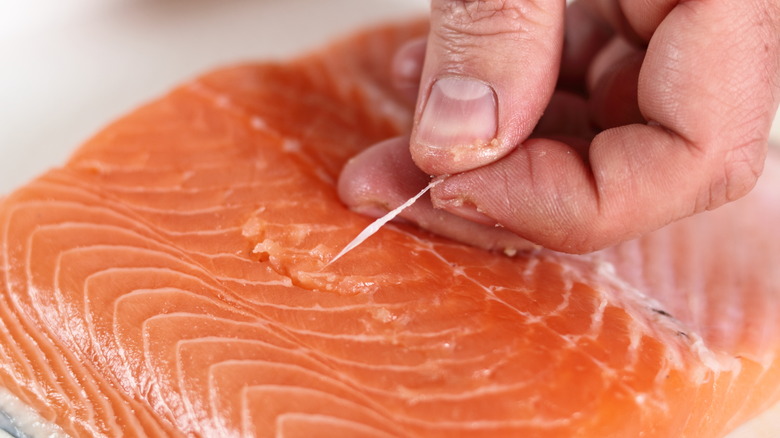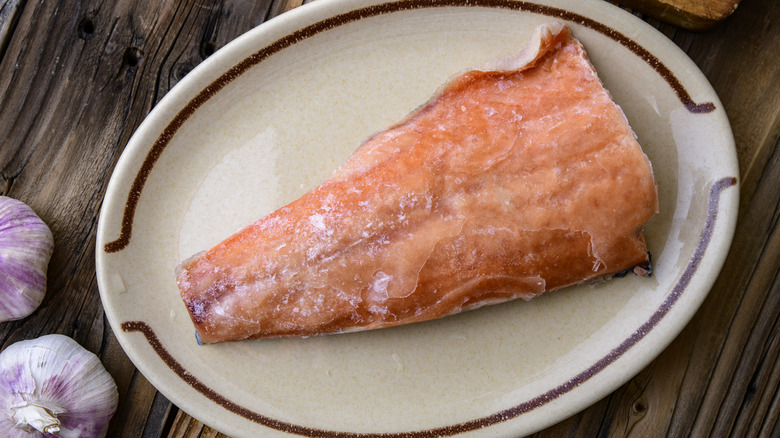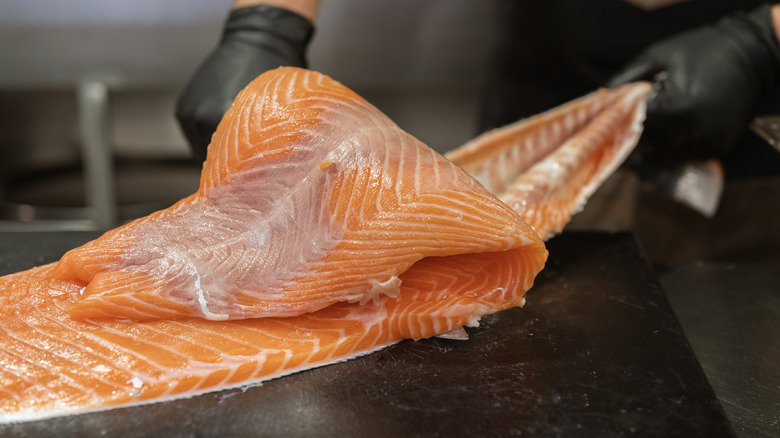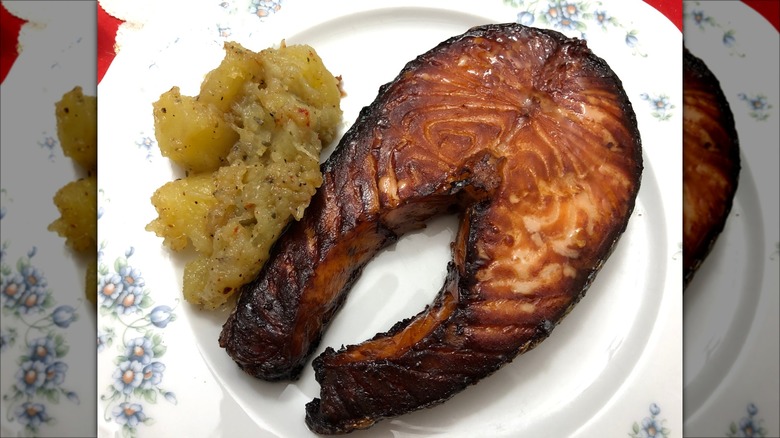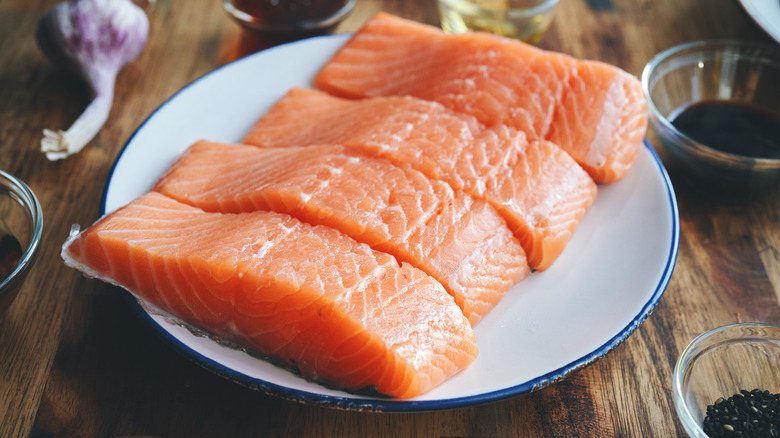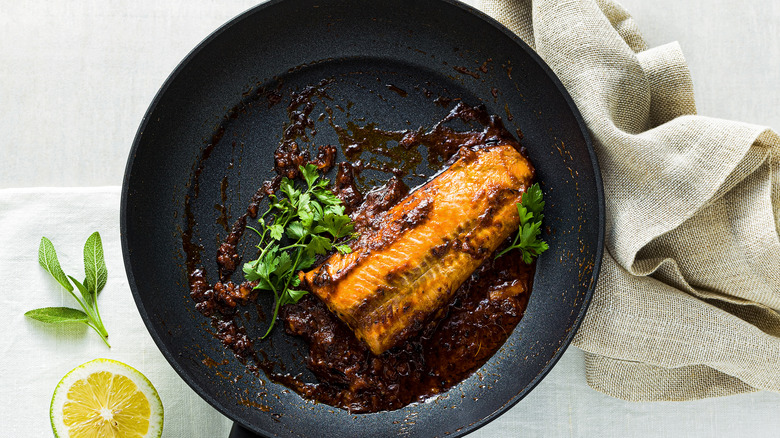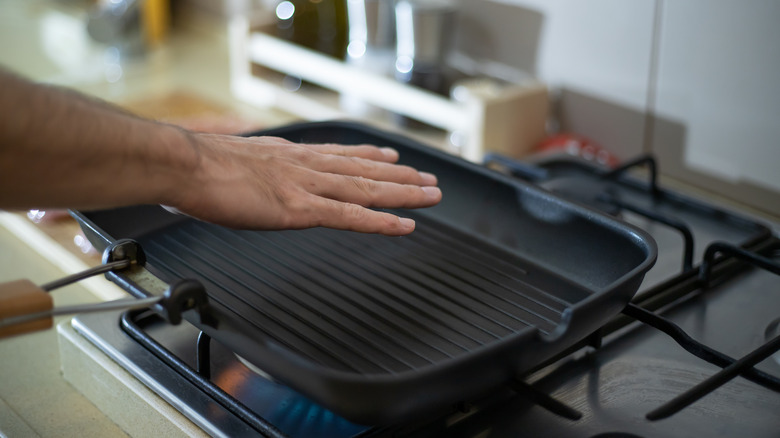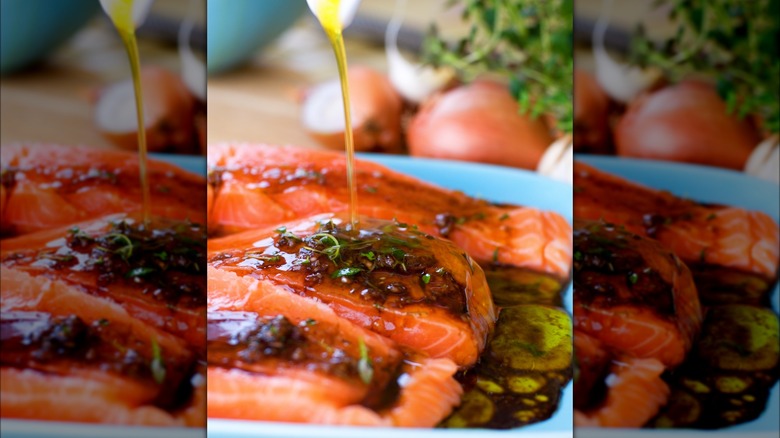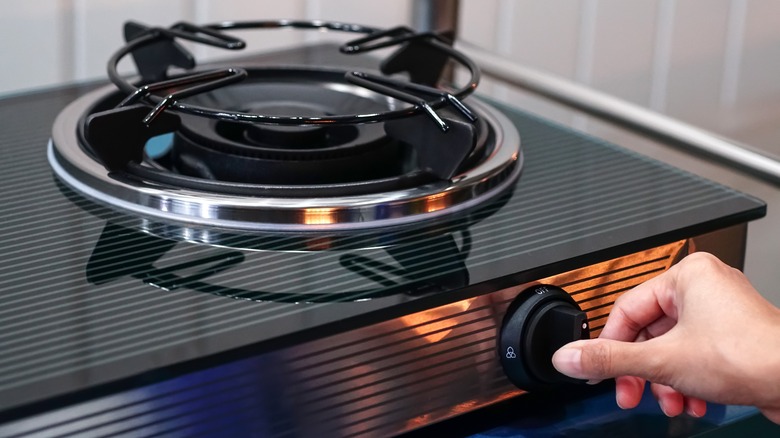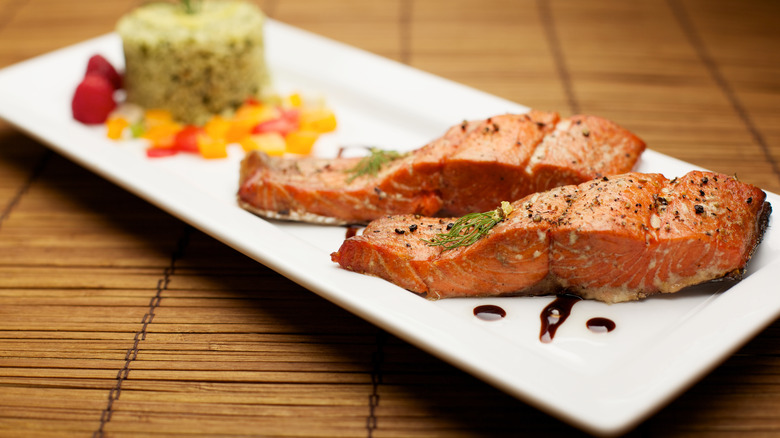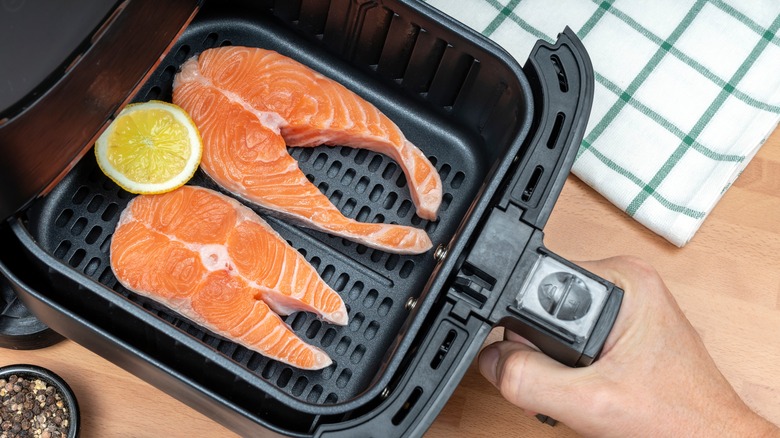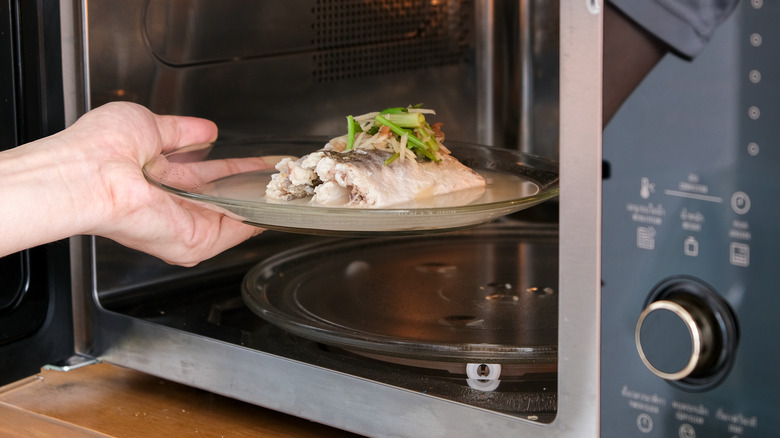13 Common Mistakes You're Probably Making When Cooking Salmon, According To Professional Chefs
Salmon is a rich and flavorful fish that lends itself well to many different cooking methods. Beyond its delicious taste, salmon is also a healthy food. It is rich in omega-3 fatty acids, which support a healthy cardiovascular system; contains high levels of DHA and vitamins that can enhance brain function; is high in protein, improves bone health ,maintains muscle mass, supports tissue repair, and so much more. However, if you try making salmon at home to take advantage of all of these benefits, you won't be able to enjoy the meal — or want to make it again — if it doesn't turn out right.
However, much like there are mistakes you can make when cooking scallops, several things can — and often do — go wrong when preparing salmon. Your lunch or dinner will be wholly unappetizing if the fish is dry, contains too many bones, or turns out mushy. We interviewed two experienced chefs to learn more about some common mistakes people make when preparing salmon and what you can do to avoid these issues. George Duran is a celebrity chef, comedian, and entertainer may have seen on Food Network's "Ham on the Street" or as the host of TLC's "Ultimate Cake Off." Sylvia Graf Carrethers is a personal chef and the owner of Simply Prima, a business serving the Annapolis, Maryland, area that offers personalized meals to match each customer's dietary needs and restrictions.
Buying end or uneven filets of salmon
While you shouldn't necessarily judge salmon by its color, you should judge it by its thickness. Sylvia Graf Carrethers explains why it is a mistake to buy thin or very uneven salmon fillets, such as the tail piece. It is more likely that thinner fillets will turn out overcooked. Graf Carrethers says, "It is nearly impossible to get a great sear and not dry out the meat, when the flesh is super thin." Conversely, with a thicker salmon fillet, Graf Carrethers explains, "you can get a nice crispy sear on the skin, take your time to also cook the other side, and still have a moist center."
Similarly, you'll also want to try to avoid uneven salmon fillets, where one part is much thinner or thicker than the rest. As Graf Carrethers notes, part of the salmon will either end up over or under-cooked. "If you would like to cook a whole fillet of salmon for a crowd — which makes for an impressive presentation — just tuck the tail end piece under a bit for even thickness," she says. If possible, Graf Carrethers recommends buying salmon from the fish counter and requesting that they cut it for you so that the fillets are the same thickness.
Not looking for pin bones before cooking
If you've ever cooked salmon at home only to be disappointed that there is a bone in nearly every bite, then you've made the mistake of not looking for the pin bones before preparing the fish. If you leave the pin bones in, you also risk choking on one of them if you swallow it while eating.
Sylvia Graf Carrethers shares a trick for removing these pesky bones. She explains, "The easiest way to remove them is to buy a pair of eyebrow tweezers (they will be for kitchen use only), slightly run your hand over the fish to feel for bones, and pull them out with the tweezers." If you want to avoid taking the time to remove the pin bones yourself or don't think you'll be able to do so effectively, consider requesting they do this at the fish counter. The Whole Foods fishmonger and other grocery store fish counters will often help prep fish for you, including removing the pin bones.
Cooking salmon directly from frozen
When preparing salmon, planning ahead and leaving time for frozen fillets to thaw is essential. According to George Duran, "Cooking salmon directly from frozen can lead to uneven cooking and a less appealing texture." Ideally, Duran recommends purchasing fresh salmon that has never been frozen and cooking it promptly.
If this isn't an option, or you want to take advantage of sales and stock up your freezer, you need to know how to properly thaw salmon. Placing frozen salmon in the refrigerator the night before you plan to use it is the best way to thaw the fish without impacting its taste or texture or increasing the chances of foodborne illness. If you forgot to put the salmon in the fridge the night before, and you still want to prepare it, you can thaw the salmon by placing the salmon in a resealable plastic bag and thawing it in cold — never hot — water. Check on the salmon after about half an hour. If it is still partially frozen, drain the water and fill the sink or container with cold water. The key is to ensure the outside of the salmon doesn't get too warm while the center continues to defrost. You don't want bacteria to multiply and threaten anyone's safety.
Removing all the skin before cooking
Even if you don't want to eat the salmon skin, removing it before you cook the fish will be a mistake. If the skin is removed before cooking, Sylvia Graf Carrethers explains that it "takes away many benefits that make salmon such a wonderful protein to include in our diet." She highlights the texture benefits that leaving the skin on will deliver. For one, the skin adds "just the perfect balance or crunch to the tender, buttery salmon fillet." Graf Carrethers also explains that leaving the skin on helps to keep the salmon more moist as it cooks.
Cooking salmon with the skin on also helps ensure you get the most nutrients out of the meal. "Salmon is rich in Omega-3 fatty acids and allowing the fat from the skin to permeate into the flesh while cooking is the best way to assure you get the maximum amount of benefits," explains Graf Carrethers.
Over or undercooking your salmon
You'll want to pretend you're Goldilocks when preparing salmon. Instead of being overcooked or undercooked, it must be just right for the best taste and safety. Chef George Duran says, "Use a meat thermometer to ensure it reaches an internal temperature of 145 degrees Fahrenheit (63 degrees Celsius)." If you let the salmon cook beyond this point, he explains that it can result in a "dry, tough fish with less flavor."
Just take care not to under cook the salmon either. Sylvia Graf Carrethers explains that salmon that hasn't reached an internal temperature of 145 degrees may be hazardous, "harbor[ing] bacteria that can cause intestinal issues and make you quite sick." While you may enjoy raw salmon at a sushi restaurant, she emphasizes that "regular store bought salmon is NOT sushi grade salmon and not meant to be served raw or undercooked." This is another reason to always use a meat thermometer when preparing salmon.
Not patting the salmon dry before you cook it
Whether it is freshly purchased or recently thawed, there will be a lot of moisture on a salmon fillet when you remove it from its packaging. George Duran explains the importance of removing this excess moisture. "Failing to pat dry the salmon before cooking can prevent a good sear and crisp skin." As the salmon cooks, the moisture will seep out onto the pan. With that much liquid, steam will form, keeping the salmon cooler than if it is in more direct contact with the hot pan.
Fortunately, drying salmon is a quick step that shouldn't interfere with your cooking plans. Chef Duran says, "Use paper towels to remove excess moisture from the surface of the fish before seasoning and cooking." Salting the fish before you cook it will also help pull out some of the excess moisture to ensure that beautiful sear you want when cooking it.
Using the wrong pan
Pan selection is also important when cooking salmon. Sylvia Graf Carrethers explains some potential problems if you choose the wrong type of pan for cooking your salmon. "Salmon skin can be one of the most rewarding or frustrating parts of preparing your meal. The wrong pan will have the skin stick to it, leaving you with shreds of it stuck to your fish, and with you trying to scrape the other parts of it off the pan."
To avoid this potential catastrophic situation, Graf Carrethers recommends cooking salmon in a nonstick pan, particularly if you don't have a lot of practice preparing the fish. With the nonstick finish, you won't need to worry as much about the skin sticking to the pan as the fish cooks. "Another good pan for the more experienced cook is a well-seasoned cast iron skillet. Make sure to coat it in oil and get it super hot before adding the salmon," Graf Carrethers says.
Failing to preheat the pan
George Duran cautions against putting the salmon in a pan that hasn't been preheated. "Starting with a cold pan can result in uneven cooking," he says. This means that part of your salmon could end up dry and overcooked while other sections have yet to reach the safe internal temperature of 145 degrees Fahrenheit. Chef Duran also explains that the salmon won't caramelize properly if the pan is not preheated before it is added. This "lack of caramelization" will leave you with a less-appetizing meal.
Instead, Duran says, "Preheat the pan over medium-high heat before adding the salmon for a nicely seared exterior." Preheating a pan takes longer than you might think. Turn the burner on to medium-high heat, and let the pan heat up for at least 5 minutes before adding the salmon, or any oil, butter, or other ingredients.
Not marinating the salmon properly
George Duran and Sylvia Graf Carrethers emphasize the importance of marinating salmon properly. Duran explains that skipping marination will likely result in your salmon lacking flavor. He recommends marinating the fish with olive oil, lemon juice, and herbs and spices. "Personally, I love adding cubes of frozen herbs, chopped garlic, and ginger, like those from Dorot Gardens, to create an instant flavorful marinade for my salmon fillets without worrying about wilted herbs/spices or flavorless dried herbs/spices."
Graf Carrethers cautions against letting salmon marinate for over 20 or 30 minutes. "The flesh of fish is a much more tender protein than meat or poultry. Marinating it too long, especially in acidic ingredients, will make your salmon mushy," she says. Set a timer to avoid letting your salmon marinate longer than recommended.
Cooking it at too high a heat
Finding the right burner temperature is crucial when cooking salmon. George Duran explains, "Cooking salmon at too high a heat can cause the outside to burn before the inside is cooked through." Not only will this leave you with a charred and unappealing piece of fish, but it could also pose a potential safety risk. If you assume the piece of fish is cooked based on the appearance of the outside and the inside has still not reached 145 degrees Fahrenheit, you could be setting yourself up for food poisoning.
Duran recommends, "Start[ing] with medium-high heat for searing." Once this fish is seared, he says to reduce the heat to"medium or medium-low to finish cooking gently." If you've been wondering what all that white stuff is that comes out of salmon as it cooks, it can also indicate that you've been cooking it over too high of a heat. The white stuff — albumin– is a protein. If the salmon is cooked for too long or the heat is too high, more of it is released. But, if some does come out, don't worry. It is harmless.
Not giving the salmon time to rest after cooking
You may have heard that roasts and other cuts of meat should be given time to rest. But did you know that the same is true for salmon? "Not allowing salmon to rest after cooking can lead to juices running out," explains George Duran. Those juices keep the salmon moist, tender, and flavorful when you bite into it. Thus, cutting into the salmon immediately after cooking will leave you with a dry and less appetizing piece of fish.
Chef Duran says, "Let the salmon rest for a few minutes before serving to allow the juices to redistribute and keep the fish moist." Salmon doesn't require a long rest time, so you won't have to wait long until you're able to cut into the fillet and enjoy it. Five minutes should be sufficient for the juices to redistribute and lock into the fish.
Not experimenting with different cooking techniques or recipes
It can be exciting to find a salmon recipe you love. And, it can also be tempting to stick to that same tried-and-true recipe to eliminate some of the mystery over whether you'll enjoy the meal. However, even the best tasting recipes lose their appeal if they're all we ever cook.
Don't let yourself get stuck in a rut by always cooking salmon the same way. Plus, as Sylvia Graf Carrethers explains, "Salmon's mild taste lends itself to try out many different ways of preparation." You'll find that there are several different ways you can enjoy it. "Think of Mediterranean style salmon with fresh basil, parsley, oregano, garlic, finished with a drizzle of olive oil," shares Graf Carrethers. "How about a ginger/lime baked salmon on top of vegetables?" As you can see there are many different recipe ideas if you use some creativity and think about different flavor pairings.
Instead of always pan-searing or baking your salmon, you can use that herald of modern culinary convenience: the air fryer. If you're wanting to cook an 8-ounce filet, just set your air fryer temp to around 400 degrees Fahrenheit and pop in a filet for around 10 minutes. Pull it out season to taste and enjoy!
Reheating salmon in the microwave
While salmon is best enjoyed right after cooking, there will be times when you have some left over or want to save a piece for lunch the following day. Just don't make the mistake of reheating the salmon in the microwave. Microwaved steak, microwaved pizza, and microwaved salmon are all going to turn out dry, hard, or lacking in flavor. Don't do it.
Instead, Sylvia Graf Carrethers explains that some of the best ways to "reheat your salmon is to air fry it for a couple of minutes or wrap it in aluminum foil and place it in a 275 degrees Fahrenheit oven until just heated through. Graf Carrethers shares an even more creative solution for warming the fish without letting it dry out. "My favorite hack for reheating fish is to microwave all of the sides for the meal extra hot, lay my fish on top of the hot sides, cover it with aluminum foil, and let it sit on the counter for a couple of minutes to absorb the heat from the sides," the personal chef further explains.
